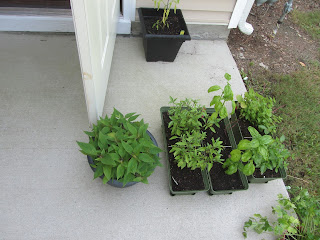Most of my herbs this year outgrew their pots within about a month. Even those that I transplanted to new pots only weeks before had filled them. How did I know? Well, the signs were pretty obvious:
- No more new growth. When I snipped my mint and no new leaves (or very tiny leaves) grew in at the branch point, I knew something was wrong.
- Bottom leaves yellowing and falling off.
- Leggy plants (especially obvious with my basil plants).
- Failure to hold water. I was watering my plants, and it was either running straight through the pot or just getting dry again hours later.
- Roots poking out the bottom of the pot.
- Exposed roots at the top of the soil.
 |
| This basil is so root-bound that I could see roots on the surface. The leaves were yellowing. The plants were leggy, and new growth was very tiny. |
Let's think about roots for a second. They're like a straw. They suck up water and nutrients from the soil and deliver them to the part of the plant we usually think about—the part above the ground. Roots age over time and eventually die or become useless. Newer roots are MUCH MUCH better at their job. As long as the plant is making new roots, it's getting plenty of nutrients and water.
When new roots stop growing, either because the plant has outgrown its pot or because the roots are rotting, the green part of the plant suffers! I've read to root prune container plants every few years to keep them growing. If the container is too crowded, though, new roots have nowhere to go, so they stop growing.
Well, let me tell you, my plants outgrew their pots in a month, so for fast growing herbs like basil and mint, I'd recommend checking on the roots a few times per growing season. I've never done this before, and my plants always stagnated later in the season. Now I know why.
Before root pruning my herbs, I did a lot of google searching and picked through what I thought sounded right. I really enjoyed this reference.
Root pruning 101:
Root pruning 101:
 |
| (Details below) |
First, remove your plant from its pot. Try to keep it intact. Chances are, if the plant is root-bound, it will slide right out. I recommend doing this over a big trash bag so you can save your soil!
- Pull off/cut off the outer roots that are tangled and forming to the shape of the container.
- Loosen (labeled tease) the roots so they hang down. If you have multiple plants in one pot, that might allow them to separate.
- Depending on the plant, remove a total of 1/3 to 3/4 of the roots. Cut the hanging roots with scissors. My general rule of thumb is if the plant roots easily from cuttings, it can handle the removal of most of its roots (and then you don't have to prune again as soon). If the plant struggles to produce new roots from cuttings/if you don't know, you can play it safe and remove less; just know that you might have to do it again sooner. When you estimate how much you've removed, don't forget what you took off in step 2.
- Repot in the same soil. If your plant is root-bound, its soil might actually have enough nutrients to support it. You can fertilize once new roots get established. Chances are the old roots took some of the soil with them, so top off the plant with some fresh potting soil, too.
- Water liberally. You just took away 1/3-3/4 of the plant's straw. Give it a full drink to make its life easier while it acclimates.
- Trim the top. Use this as your chance to use some extra herbs or grow some cuttings. Don't go crazy, just give it a little haircut. Remove anything shooting out that might take a lot of energy for the plant to feed, and remove any leaves that aren't green. Yellowish leaves don't have as much chlorophyll, so they won't produce as much energy for the plant.
- Keep the plant in the shade for a day or two, even if it usually likes the sun. You don't want it to dry out.
- After this first watering, be careful NOT to overwater. Chances are that your plant won't use as much water as it was before its root pruning.
All my mint, basil, lemon balm, and pineapple sage got a serious root pruning:
 |
| Pineapple sage fell right out of the pot |
 |
| Pineapple sage, Thai basil, Italian basil, and mint in the shade after their root pruning |
 |
| Lemon balm and mint after root pruning |
The plants looked healthier right away (within a day or two). Now, it's been a little over two weeks, and they're producing better and staying greener. The pineapple sage has its delicious scent back, too! I've learned that the older leaves don't really smell as nice as the new growth.
 |
| Plants 16 days after root pruning. Subtle improvements in color and growth. |
Here are pictures of those same plants ~2 weeks later. The basils and mint have had quite a few trimmings too. The difference might be subtle at this point, but they're greener and a bit bushier. Hopefully, they'll keep growing for the rest of the summer.
Hopefully, within a few days, your plant will be back to normal and will be able to keep producing some flavor for your kitchen!



No comments :
Post a Comment